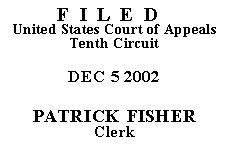

| UNITED STATES OF AMERICA, | No. 01-3381
D.C. No. 01-CR-40024-01-SAC |
Relevant Conduct
The district court calculated the total amount of methamphetamine attributable to Vega to be 2,112.3 grams, establishing a base offense level of 34. U.S. Sentencing Guidelines Manual § 2D1.1(c)(3). It reached this total by adding the following drug quantities:
(ROA at 206.)
Vega challenges several aspects of this calculation. We review the district court's factual findings for clear error, bearing in mind that the government bears the burden of proving the quantity of drugs by a preponderance of the evidence. United States v. Ortiz, 993 F.2d 204, 207 (10th Cir. 1993). We review the application of the Guidelines to the facts de novo. Id.
Vega first challenges the court's reliance on the testimony of Roger Zimmerman that Vega sold him six quarter-pounds and one-half pound of methamphetamine between December 2000 and March 14, 2001. "Where there is no drug seizure or the amount seized does not reflect the scale of the offense, the court shall approximate the quantity of the controlled substance," U.S. Sentencing Guidelines Manual § 2D1.1 n.12 (2001), based on information that has support in the facts of the case and sufficient indicia of reliability. United States v. Ruiz-Castro, 92 F.3d 1519, 1534 (10th Cir. 1996).
In this case, the district court found that sufficient indicia of reliability surrounded Zimmerman's testimony that Vega had sold him these quantities of methamphetamine. (ROA at 205.) Zimmerman's statements regarding these sales remained consistent from the time of his initial arrest to the sentencing hearing, (ROA at 107, 116, 122), and his testimony was consistent with Vega's willingness to front Zimmerman large amounts of drugs shortly after March 14, 2001. (ROA at 107-09.) Zimmerman was also arrested with over a quarter-pound of methamphetamine in his possession. Finally, the district court included only the lowest number of transactions estimated by Zimmerman in the calculation of the total amount. Thus, the district court's inclusion of these amounts was not clearly erroneous. See United States v. Browning, 61 F.3d 752, 754-55 (10th Cir. 1995) (affirming the district court's calculation of drug quantity where the witnesses' testimony on the amount was consistent from the pre-sentence investigation to the sentencing hearing and the district court adopted the more conservative estimate of the quantity).
Second, Vega contends that the district court double-counted certain amounts of methamphetamine by including quantities found in Zimmerman's possession when he was arrested and quantities that Zimmerman testified Vega had sold him prior to Zimmerman's arrest. This argument fails because the amounts found in Zimmerman's possession were not included in the total amount. (ROA at 206.)
Third, Vega contends that the 617.3 grams of methamphetamine seized from the car trunk of his co-defendant Jose Parga should not be included because there was no proven relationship between Parga and Vega. Under the Sentencing Guidelines, Vega is "accountable for all quantities of contraband with which he was directly involved and . . . all reasonably foreseeable quantities of contraband that were within the scope of the criminal activity that he jointly undertook." U.S. Sentencing Guidelines Manual § 1B1.3 n.2 (2001). The district court found that the methamphetamine in Parga's car was attributable to Vega because it was reasonably foreseeable in connection with this criminal activity. (ROA at 207.)
The inclusion of this 617.3 grams is not clearly erroneous. At his arrest and during an April 5, 2001 interview, Parga informed the police that he was holding the 617.3 grams found in his trunk for Vega. (ROA at 81, 84, 205.) This statement was corroborated by the fact that, after negotiating the sale of one pound of methamphetamine with Zimmerman on March 27, 2001, Vega traveled to Parga's apartment and then returned to Zimmerman's with the drugs. (ROA at 81, 84, 89-90.) Thus, the factual record supports a finding that the 617.3 grams of methamphetamine in Parga's trunk belonged to defendant Vega.
Because the district court's findings regarding the relevant conduct are not clearly erroneous, we affirm the calculation of Vega's relevant conduct and base offense level.
Aggravating Role
Vega also appeals from the district court's imposition of a two-level sentence enhancement for his role as an "organizer, leader, manager or supervisor" of his co-defendants Parga and Ramon Villares-Palacios in the criminal activity. U.S. Sentencing Guidelines Manual § 3B1.1(c) (2001). Factors to consider when evaluating whether a defendant should receive this enhancement include
the exercise of decision making authority, the nature of participation in the commission of the offense, the recruitment of accomplices, the claimed right to a larger share of the fruits of the crime, the degree of participation in planning or organizing the offense, the nature and scope of the illegal activity, and the degree of control and authority exercised over others.
Id. at n.4.
In determining that Vega should receive this enhancement, the district court made specific factual findings that Vega negotiated the transactions with Zimmerman, instructed Villares-Palacios to assist him in the transactions, had Villares-Palacios accompany him on numerous transactions, exercised the authority to advance drugs to Zimmerman, and used Parga to store and distribute drugs to him. (ROA at 210.) These findings are supported in the record and suffice to show that Vega was an organizer, leader, manager or supervisor of the operation.
For the foregoing reasons, we AFFIRM the judgment of the district court.
ENTERED FOR THE COURT
David M. Ebel
Circuit Judge
*.After examining the briefs and appellate record, this panel has determined unanimously to grant the parties' request for a decision on the briefs without oral argument. See Fed. R. App. P. 34(f) and 10th Cir. R. 34.1(G). The case is therefore ordered submitted without oral argument. This order and judgment is not binding precedent, except under the doctrines of law of the case, res judicata, and collateral estoppel. The court generally disfavors the citation of orders and judgments; nevertheless, an order and judgment may be cited under the terms and conditions of 10th Cir. R. 36.3.